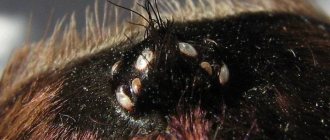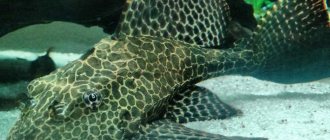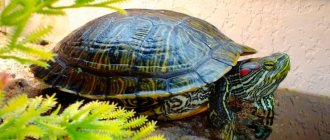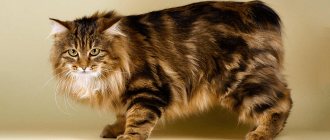Description
Aravana is a predatory fish. In nature, it lives in large rivers and basins of America, Africa and Southern China. The origin of freshwater fish begins in South America. In addition to being kept in an aquarium, arowana is used as food. Asian arowanas differ from American arowanas by having a short body.
Appearance
The fish reaches a length of 80 cm, in rare cases 120 cm. The body of the fish is long, ribbon-like, covered with large scales, which makes it look like a dragon. The fins are long and narrow, almost adjacent to the tail. The large mouth opens upward and allows the arowana to take food from the surface. Sensitive antennae are located on the lower jaw.
Behavior
The fish can jump to a height of 3 m from the surface and swims quickly. A skilled hunter, capable of obtaining food even on land. In nature, arowanas build a clear hierarchy when the dominant individual occupies a territory and does not allow weaker relatives to approach it. In the same aquarium, two individuals will inevitably have violent clashes. Despite their bloodthirstiness, dragon fish are shy. A sharp bright light or a sudden sound will cause the arowana to rush around the aquarium in panic. Smart fish that recognizes its owner.
Lifespan
Arowana lives 7–10 years with good care.
Features of feeding
Under natural conditions, these relict fish are predators that not only lie in wait and quickly pursue small fish and amphibians, but also hunt aerial and terrestrial insects and small mammals. Seeing small birds sitting on overhanging branches or large insects flying by, the fish powerfully pushes off from the water column and jumps high into the air, grabbing its prey with its huge mouth.
Therefore, in an aquarium they can be fed with live grasshoppers, crickets, marbled cockroaches, gammarus, both live and frozen. Dragon fish happily eat live baby frogs and small fish, but you should be sure that the food is completely sterile, otherwise your expensive fish may become infected with parasitic diseases.
Large fish are fed with pieces of chicken, strips of fish and even small mice. However, it is worth considering that a monotonous diet with a predominance of protein foods leads to obesity and liver diseases. The diet should be varied, including dry, freeze-dried and frozen food. The only condition when feeding ready-made food should be its “buoyancy”, because fish are only interested in floating food. The one that fell to the bottom is not seen by the fish - this is how their organs of vision are designed.
Kinds
There are approximately 200 species of arowana, but about 10 are often kept in aquariums. The silver arowana is popular and is sold at a more affordable price.
Asian red
Famous and expensive fish from Southeast Asia. Body color is bright red. Endangered species. The owner must have a certificate of ownership.
Golden
Another endangered species. Young fish look less impressive than adults. The fish has a rich yellow-gold color and five horizontal rows of scales.
Black
Young black arowanas have dark fins and white and yellow stripes on their scales. As fish age, their scales darken.
African
African dragons differ from members of the family in structure. They live in the upper Nile, another rare species. Female African Arowanas look less bright.
Platinum
A unique fish with a perfect light color without inclusions of other colors. It grows up to 40 cm. It has another feature - it squints in one eye due to feeding from the surface. One platinum Arowana was offered for sale in Singapore, but the owner changed his mind and refused to sell.
Australian
Also known as pearl giardini. Smaller than other arowanas. Large scales with a pinkish edging, there are seven rows of scales. There are small light spots on the tail and fins.
South American silver
This species is cheaper than the Asian Arowana. The silver arowana lives in the Amazon basin. The scales of the fish shimmer in the light. The tail is wedge-shaped, the fins practically merge with it.
Myanmar
The species is especially popular in Asian countries. Also known as painted arowana. There is an intricate pattern on the light brown scales. It was discovered on the southern outskirts of Myanmar. It grows on average up to 60 cm in length.
Arowana fish: description
Common to all species of the Aravanaceae family is the structure of the body and the condition of the scales. The body is long and streamlined, bending in movement like a snake. The muzzle seems to be raised upward, the lower part of the head (under the lower jaw) can swell greatly, taking the shape of a pouch. His appointment will be reviewed at a later date.
The structure of the scales of all known species contributed to the fact that in the countries of East Asia the fish was nicknamed the dragon. The scales are large, very hard, and fit tightly to each other, creating a kind of shell. But at the same time, such scales do not prevent the fish from moving very gracefully.
The fins are hard and low.
- The dorsal and pelvic fins, as a rule, start from the middle of the body and pass into the caudal fin at the back.
- The pectoral fins cannot be called large, but they are quite dense and powerful.
- The color of the fins usually matches the color of the body.
The color varies. We can say this: as many color options as there are, there are as many varieties. In natural conditions and in aquariums, silver, green, pearl, black, gold and even platinum “dragons” are found.
But no matter what color the individual is, the color is always saturated or, as artists say, dense.
The eyes are round, slightly protruding, with a bright black pupil.
The size of the arowana depends on where you live. South American species reach sizes of 40–80 cm, “Asian” and “Australian” species are larger - from 0.8 to 1.2 meters.
Content
Such rare and exotic fish live in professional aquariums. The equipment, the aquarium and the fish itself are very expensive.
Aquarium
You will need a tank with a volume of 800–1000 liters made of durable material, such as plexiglass. A heavy lid is required on top, as the fish jump out of the water. For decorations, use large driftwood.
Water parameters
| Temperature | 20–30 degrees |
| pH value | 6–7,5 |
| Rigidity | 8–12 dGH |
| Water movement | moderate or weak |
Change the water once a week by 25%. Do not allow sudden changes in parameters. Periodically test the water for hazardous chemicals and add water conditioner if necessary.
Plants
Plants in an arowana aquarium are not necessary. If you want to plant plants, choose flora with a strong root system:
- Vallisneria;
- Java fern;
- Anubias.
It is better to prepare small pots for plants; with such planting they will be less vulnerable. Use artificial plants as an alternative to living greenery.
Priming
Choose soil with a large diameter without sharp corners. For the rest, be guided by your own preferences. The bottom, strewn with leaves, will recreate the natural habitat in the aquarium. Siphon the soil thoroughly once a week.
Equipment
A set of equipment for the maintenance and high-quality care of the arowana:
- External filter. Arowanas quickly pollute water. Choose a powerful device; it should make at least three revolutions of water per hour. Multiple filters may be required. Better filtration is carried out by mixed type filters - mechanical and biological.
- Compressor. The liquid must be saturated with oxygen. A powerful compressor together with plants will ensure the arowanas breathe. A lack of oxygen is indicated by rapid breathing of the fish and its predominance in the upper layers of water
- Heater. Placed as needed if the room is not warm enough.
- Cooler. Necessary in the summer if the water temperature rises above 30 degrees. The replacement is canisters and ice packs, which gradually cool the water.
Lighting
Arowanas live in dim light. Equip the lighting system so that the light turns on gradually and does not stress the fish. First, smoothly turn on the light in the room, then in the aquarium. Metal halide and LED lamps are suitable for lighting a large aquarium. Lamps should not overheat the water. Think about heat dissipation in advance. You can install the light on an aluminum plate or place a cooler. If there are live plants in the pond, make sure they have enough light.
View this post on Instagram
#superred #arowana #dragonfish #southeastasia #asia #arowanafish #australia #ornamentalfish #superredarowana #dubai #england #guangzhou #beijing #shanghai #indonesia #japan #southkorea #korea #taiwan #russia #hongkong #australia #mengjier #india #ornamentalfish #singapore #china #monsterfishkeepers #ultraredarowana #europe #asianarowana #mpu
A post shared by PTMunjulPrimaUtama (@ptmunjulprimautama) on Sep 25, 2021 at 8:52pm PDT
Keeping in an aquarium
This type of fish requires a long, not very high aquarium, where the long arowana can swim freely. Fish have a very strongly developed territorial sense, so if there are several individuals, then they need a lot of space so that crowded conditions do not provoke aggression.
Decorative elements and landscaping in the aquarium are optional. It is better to fill the bottom with coarse river sand or small, well-rolled pebbles. The water should be warm, because the fish comes from subtropical waters. Therefore, it must correspond to natural conditions:
- t =24-30°C;
- dH 5-15°;
- pH 6.5-7.5.
Despite the fact that the water in natural reservoirs is poor in oxygen, for comfortable keeping of an arowana it requires active aeration, good filtration and weekly 30% water changes. The stream of water from the filter needs to be distributed along the bottom so as not to create a strong current - the fish are not used to it.
If, nevertheless, the owner decides to decorate his home pond with green plants, then experts recommend planting it with plants with a good root system and burying it deep into the ground, otherwise fish may tear out the plantings. Another convenient way is to garden with plants in pots. It is better to place them around the perimeter of the reservoir so that they do not interfere with the fish’s swimming.
The aquarium must be covered with durable glass, since arowanas, which easily jump to a meter height, can fall out. Special lighting should also be provided - adjustable incandescent lamps or dimming with the help of plants floating on the surface.
Feeding
The arowana's diet consists mainly of animal feed:
- frogs;
- tadpoles;
- coreters;
- grasshoppers;
- mice;
- beef and chicken heart;
- crickets;
- bloodworm;
- small fish;
- shrimp;
- mussels;
- Zhukov.
Some animals, such as fish and crickets, can be raised at home. Fish and insects should not show signs of illness. Treat feed in baths of methylene blue solution, others in boiling water. Remove the fat from the meat and cut into 1 cm pieces. Do not overfeed the predators; give them a fasting day 1-2 times a week. In its natural environment, the arowana occasionally consumes plant foods such as aquatic plants and fruits that have fallen into the water.
What difficulties may there be in the content?
There is no particular difficulty in keeping an arowana. These ancient fish are practically omnivorous, tolerant of oxygen levels in the water, but they require a large volume of home pond. The length of the aquarium should be at least 1.2 m. It can be small in height (~ 60 cm), but the volume per individual should be 250 liters.
Fish do not tolerate fluctuations in water characteristics well, so you should not introduce arowanas into an unseasoned aquarium. In addition, fish are frightened by sudden flashes of light.
Compatibility
Optimally single content. Goldfish, viviparous fish, carp fish and medium-sized cichlids are regarded exclusively as food. It is acceptable to keep an arowana with large neighbors:
- paku;
- giant gouramis;
- astronotuses;
- Indian knife;
- slobbering catfish;
- plecostomus;
- brocade pterygoplicht.
Do not allow the predator to go hungry, equip the aquarium with numerous hiding places and maintain the most comfortable conditions, then the arowana will get along with its neighbors.
View this post on Instagram
My aquarium Double Tap & Comment Below ?FOLLOW FOR MORE @polysaur_jurassicfish #bichir #endlicheri #senegalus #fish #bichirbichir #delhezi #primitivefish #freshwater #congicus #fishtank #aquarismo #aquario #freshwaterfish #aquariumhobby #exoticpet #africanfish #bichirs #aquarium # fish #ポリプテルス #fish #arowana #jardini #garfish #spottedgar #monsterfishkeeper #polypterus #アロワナ #poytara #mbreda
A post shared by Primitive fish (@polysaur_jurassicfish) on Sep 28, 2021 at 5:26pm PDT
Arowana diseases
In general, these fish have strong immunity. But if the aquarium is extensively damaged by fungal or bacterial infections, the arowana will also become infected. Signs are standard for all aquarium fish: spots, plaque, cloudiness of scales.
If the filter fails to clean the water, the fish's gills may roll up. If the pH level is too high, the arowana loses its vision and its eyes become cloudy.
Prevention of diseases - timely proper care of the aquarium and monitoring water parameters.
Reproduction
Arowana does not breed in an aquarium. It is possible to breed fish in ponds and pools.
Sex differences
Sexual dimorphism is weakly expressed. The male looks somewhat more graceful and has a long anal fin. In some species, the color of males is more intense.
Spawning
Fish spawn in warm water. The male carries the eggs, 1.5 cm in diameter, in his mouth for 4–5 weeks and is in no hurry to release the fry even after hatching. The young begin to swim independently after 3–4 days. First, the fry feed on the contents of the yolk sac, then on daphnia, worms or insect larvae.
Arowana varieties
Rare and valuable representatives of the prehistoric period are considered an endangered species. Arowanas are bred only in specialized nurseries in China, Indonesia, Vietnam, Burma and Cambodia. There are many varieties of dragon fish; gold and ruby colored fish are considered especially valuable.
Each dragon fish bred in an official nursery is microchipped and has its own passport.
Common types of unique fish include the following:
| Name | Description | Comments |
| Asian | grows up to 90 cm, popular and one of the most expensive species, red arowanas are considered the most valuable | The owner of the fish, instead of the individual, receives all the information about the pedigree and a certificate of ownership |
| Pearl (Australian) | priced cheaper than Asian relatives, has small scales with numerous colored spots | common in New Guinea and Northern Australia, can have copper-gold, silver and amber colors |
| Silver (South American) | the most common and affordable species, distinguished by elongated fins | lives in the Orinoco and Amazon river basins, in nature grows up to 1.5 m |
| African | very rarely found in aquariums, differs in the structure of the oral cavity and the elongated shape of the head | can be seen in the river complexes of Chad and the Nile, adults are similar to catfish |
| Golden | a color variety of the Asian species, has a very bright golden color, similar to precious metal ingots | found in rivers of Western Malaysia |
| Black | grow more than 1 m, at a young age they have yellowish stripes on the body, as they grow older the scales become rich gray | lives on the territory of the Orinoco and Rio Negro rivers (Colombia, Brazil), settles in small, quiet creeks |
| Platinum | a unique species related to a natural mutation, snow-white color, without the slightest presence of another shade, the size of the individual reaches 40 cm | An unusual feature is the eyes of the platinum arowana, or rather one eye that constantly looks down |
| Myanmar (painted) | the color of the scales is unusual, each of which has a unique symbol | found in the southern regions of Myanmar |
Because of the arowana's unique talent of jumping high, the local population calls these fish “river monkeys.”
The most common is the silver arowana. But the most valuable is platinum. Fish of this subspecies is estimated to cost more than 400,000 Euros.
Diseases
The water dweller has a strong immune system. The fish does not have any species-specific diseases and is susceptible to the same diseases as other aquarium fish. The disease starts in the aquarium due to infrequent and improper maintenance. If a white coating or dots appear on the fish’s body, the pet has a fungal infection. Treat the predator with malachite green or medications containing phenoxyethanol. Poisoning and temperature shock require gradual improvement of conditions and adjustment of temperature to a comfortable level.
With whom can Arowana be combined?
Arowana is a predator that occupies the upper layers of water, capable of loitering in the water column for a long time or quickly rushing at prey. You should not hope that animals smaller in size than the arowana will peacefully coexist with it in the same aquarium.
Arowana will share water spaces only with individuals of equal size or larger ones. They coexist well with stingrays - they not only have the same food preferences, but also different “levels”. This way they will not intersect and conflict. Also, large loaches, brocade catfish, and large angelfish will not be eaten. If the volume of the aquarium allows, and the arowanas are well-fed, then there is no need to worry about the integrity of the neighbors.
Photo gallery
Breeding the Silver Arowana
It is almost impossible silver arowanas by appearance This can only be done through DNA testing or during spawning.
Most arowana breeders do the same thing as koi carp owners to determine the sex of fish: a small piece of tissue is plucked from the fin of the fish, which then serves as material for DNA analysis.
To date, only three cases of silver arowana in captivity have been recorded.
Spawning is very vigorous and occurs in the upper layers of water, usually during the new moon. The female arowana lays up to several dozen, and sometimes more than a hundred, very large eggs. Their size in a swollen state can reach ten or more millimeters in diameter. One egg is the size of a cherry!
After the eggs are fertilized, the male takes them into his mouth, where they are incubated for several weeks, during which time he does not feed. The brood size ranges from 10 to 40 individuals.
The hatched larvae, by aquarium standards, are simply giants, their size reaches 6 cm. Until the yolk sac is reabsorbed, they continue to be in the male’s mouth.
Young specimen of silver arowana
It is advisable to separate juveniles from adult fish as soon as possible. Usually, to do this, they force the male’s mouth to open, or wait until the fry leave it on their own. The method used depends on the behavior of the producers. If they care about their fry, then they can be left together. But if the offspring are eaten, the fry must be removed. This will not only save their lives, but will also shorten the interval between spawnings.
Silver arowana fry grow quickly, feeding on adult brine shrimp and young viviparous fish, such as mollies. It is undesirable to keep all the offspring together, because this will lead to fights and the death of weak individuals.
Diseases and treatment
Arowana can be susceptible to various diseases and the sooner it is detected, the more successful the treatment will be.
- Toxicosis - the fish lies calmly on the bottom or near the surface of the water, while it experiences convulsions. In advanced forms of toxicosis, the fish loses its appetite. To cure the fish, you need to change the water several times or transfer the fish to another aquarium with clean water.
- Body injury - the fish behaves timidly and it can be injured on the internal parts of the aquarium, or if it is not covered, then when it falls onto the floor, the fins and scales are injured. All parts of the body damaged by injury are restored, but to help the fish, it is planted in a vessel with 5% salt water for 5 minutes. The procedure is done 3 times a day. Already on the fourth day the wounds heal. If the wounds occupy a large surface area of the fish’s body, then the entire area is treated with a weak iodine solution.
Actually, this fish has excellent immunity, and if it is properly kept, it will not be infected with various bacteria. The best prevention is its correct content.
Arowana is not a fish for beginner aquarists. They are mainly bred to decorate public places or professional aquariums, where the maintenance is supervised by experienced workers.











